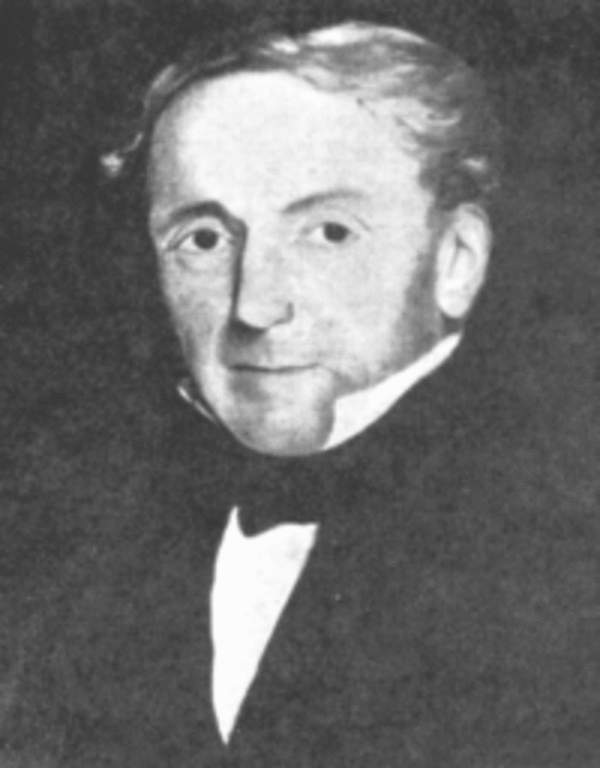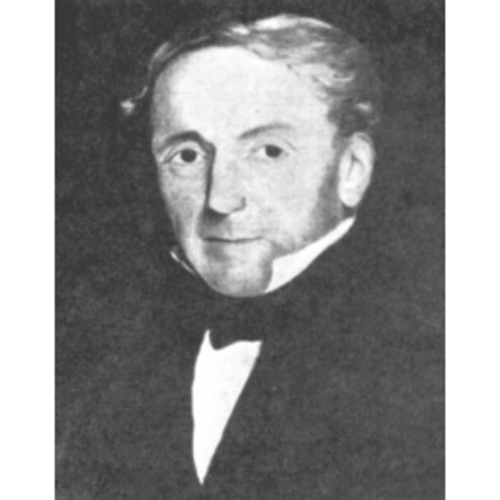
Source: Link
NISBET, THOMAS, cabinet-maker, upholsterer, militia officer, and businessman; b. c. 1777 in Duns, Scotland; m. 28 March 1803 Margaret Graham in Glasgow, and they had three sons and four daughters; d. 28 Dec. 1850 in Saint John, N.B.
Thomas Nisbet immigrated to New Brunswick in 1812 after being trained as a cabinet-maker under his father and working for a period in Glasgow. He set up business as a cabinet-maker and upholsterer on Prince William Street in Saint John. Although he was to occupy several different locations, his residence and business would remain on that street. He took the oath of freeman of the city of Saint John as a cabinet-maker in 1814.
Shortly afterwards, Nisbet imported from Jamaica a large quantity of mahogany; he was the first cabinet-maker in Saint John to import his own supply of this wood. Subsequently, he often advertised mahogany for sale at his ware-room. He worked primarily in mahogany and birch, but occasionally used maple, pine, and rosewood. His furniture falls within the Hepplewhite, Sheraton, Classical Revival, Regency, and American Empire styles and incorporates designs that were current in Great Britain and the United States.
Nisbet supplied furniture to cities other than Saint John. For example, he shipped a load of furniture to Fredericton in 1817 and again in 1830, in addition to having an agent there for a time. He employed numerous journeymen cabinet-makers, apprentices, turners, and carvers in his business. His was the first cabinet shop in Saint John to advertise the sale of piece-work to other cabinet-makers for use on their furniture. Nisbet’s ware-room advertisements reveal that, in addition to his own productions, he sold imported items such as tea-caddies and portable writing-desks as well as curtain pins, picture-frame mouldings, brass stair-rods, and other fixtures for appointing the home. About 1822, he expanded his importing activities by joining with James Stewart to form James Stewart and Company. The firm dealt in British and East Indian goods, which were sold at its store on St John Street. The partnership was terminated in May 1828.
In April 1824, fire destroyed a portion of Saint John, and the principal sufferers were Nehemiah Merritt, Noah Disbrow*, Thomas Adams, and Nisbet, with combined losses of £20,000. The New-Brunswick Courier stated that “the two latter, who are very industrious mechanics, deserve our deepest sympathy.” Nisbet lost a property he had recently purchased and fitted up consisting of a dwelling-house and ware-room, as well as buildings in the rear, including workshops and stables. He subsequently ran an advertisement asking for early payment by those indebted to him, but there is no evidence that he was forced to mortgage or sell property to begin operating again. Within a week, he had resumed business in the premises he had vacated on purchasing his new property. By April 1825, he had erected on the site of the fire a brick building for his home, ware-room, and workshops.
Nisbet’s output was greatest in the 1820s, judging by the quantity of advertising he did to sell furniture and to hire journeymen cabinet-makers. His capabilities, reputation, and business acumen are illustrated by the work he did for the province. When the arrival of Lieutenant Governor Sir Howard Douglas* was imminent in 1824, the House of Assembly allotted £750 for suitable furniture to decorate the public rooms of Government House in Fredericton and also made available funds for fixing up the residential portion of the building. Nisbet was involved in some of the repairs to Government House and received more than £170 for the work. Originally, the new furniture for the public rooms was to be obtained from England through John Bainbridge and Henry Bliss*, the provincial agents in London. In the end, however, Nisbet provided furniture valued in excess of £880 while Bainbridge and Bliss furnished items worth nearly £424. The nature of the repairs and of the furnishings Nisbet supplied is not known.
In September 1825, Government House caught fire, and the whole building with the exception of the northwest wing burned. The furniture was saved, but Nisbet subsequently provided a number of unspecified articles for the public rooms as well as furniture for the Council Chamber. About the same time he was also paid as agent in the acquisition of a residence for the lieutenant governor in Saint John.
In 1834, Thomas Nisbet Jr became a co-partner in his father’s business, which was then styled Thomas Nisbet and Son. The firm’s advertising was much reduced in the 1830s and 1840s, possibly the result of Nisbet Sr’s interest in other areas. In 1840 and 1841, however, the company fitted up and furnished the new Executive Council chamber at a cost in excess of £740. When Thomas Jr died in 1845 at the age of 35, Nisbet placed a public notice in the newspapers calling for the settling of debts to and claims against both the firm and his son’s estate. In the same advertisement, he stated that he had on hand an extensive assortment of superior new furniture. Nisbet did not dissolve Thomas Nisbet and Son until he assigned all his stock of furniture, materials, and tools to another son, Robert, in 1848. The business was carried on by Robert Nisbet until 1856.
After 1834, Nisbet had become heavily involved in two companies, the Saint John Mechanics’ Whale Fishing Company and the Saint John Hotel Company. Charles Coles Stewart, the pioneer of the whale-fishing industry in Saint John, had fitted out the city’s first whaler, the James Stewart, in 1833. It returned with a full cargo of oil and whalebone in April 1835. Inspired by this success, an organizing committee including Nisbet and John Haws* and 130 other mechanics and tradesmen from Saint John petitioned the House of Assembly that year to incorporate a whaling company. The legislature passed the act in June 1835, and by August all 5,000 shares at £10 each had been subscribed. Nisbet was elected to the first board of directors and then president, an office he held until his death.
Between May 1836, when its first whaler, the Mechanic, was launched, and November 1848, when the last whaler was sold, the company owned five ships which made a total of eleven whaling cruises With the introduction of petroleum and the subsequent decline in demand for whale oil, the company began to consider closing down in late 1845. The remaining four ships were sold over the next few years, property was let and sold, and in 1850 the House of Assembly was petitioned to enact a bill authorizing the winding up of the company’s affairs, which it did. The company had apparently been successful since it paid regular dividends from 1841 to 1854, reaching as high as 20 per cent in one year.
The act incorporating the Saint John Hotel Company was passed in 1835. With Moses Henry Perley* and others, Nisbet was elected to the first board of directors; he subsequently served as president from 1837 to 1849. The hotel opened to the public in November 1837 in the Masonic Hall, which had been renovated and furnished. It was always leased to various hotel-keepers so that the company did not operate the hotel on a day-to-day basis. During Nisbet’s presidency, the company declared biannual dividends from May 1842.
In addition to his business involvements, Thomas Nisbet was an elder and trustee of St Andrew’s Presbyterian Church, was active in the St Andrew’s and Highland societies, and was a freemason. He was also involved in the Saint John militia, from which he retired with the rank of captain in August 1834.
Thomas Nisbet was prominent in both the public and the commercial life of Saint John, but it is as a cabinet-maker that he is remembered today. He ran a well-managed and productive furniture business employing stylish designs, excellent materials, and good workmanship. That he had superior ability is illustrated by the labelled pieces which have survived. Among the more important of these are a sofa-table, writing-sewing stand, and sofa at the Royal Ontario Museum in Toronto, card-tables and a writing stand at the New Brunswick Museum in Saint John, a chest of drawers at the Beaverbrook Art Gallery and a chair and drop-leaf table at the York-Sunbury Historical Society Museum, both in Fredericton, and a card-table and desk at Kings Landing Historical Settlement, near Fredericton.
City of Saint John, N.B., City Clerk’s Office, Common Council, minutes, IV: 68 (mfm. at PANB). N.B. Museum, Church of England burial ground, Westmorland Road (Saint John), records (mfm.); Nesbitt family, cb doc (typescript); Ward family papers, packet 7, no.8. PANB, RG 4, RS24, S33-Z1.2, S34-R6.3, S35–R3.33, S37–Z11.5, S45-P84, S46-P1, S57-P67, S63-P328; RG 10, RS 108, Thomas Nisbet, 1820. N.B., House of Assembly, Journal, 1826–27. City Gazette (Saint John), 1812–41, esp. 10 April 1813; 14 July 1819; 16 Feb. 1820; 6 June 1821; 22 May, 13 June, 21 Nov. 1822; 24 July 1823; 15 April, 24 June, 2 Sept. 1824; 13 May 1837. Herald (Saint John), 18 Aug. 1841. Morning News (Saint John), 16 Aug. 1841. New-Brunswick Courier, 1812–50, esp. 28 Jan., 6 March 1815; 12 Oct. 1816; 9 June 1821; 10 April 1824; 24 Sept. 1825; 29 March 1828; 2, 30 Aug. 1834; 4 April, 12 Sept. 1835; 28 May 1836; 10 June, 18 Nov. 1837; 14 May 1842; 8 Feb., 1 March, 11 Oct. 1845; 2 Sept., 18 Nov. 1848; 12 May 1849; 2 Nov. 1850; also 11 Oct. 1856. Royal Gazette (Saint John; Fredericton), 1812–50, esp. 2, 16 March 1815; 29 July 1817; 13 April 1824; 20 Sept. 1825; 23 June 1830. Star (Saint John), 18 June 1822; 26 April, 31 May 1825. Weekly Observer (Saint John), 19 Aug. 1834, 11 Aug. 1835. W. F. Bunting, History of St. John’s Lodge, F. & A.M. of Saint John, New Brunswick . . . (Saint John, 1895), 346–47, 368–69, 397–98. C. H. Foss and Richard Vroom, Cabinetmakers of the eastern seaboard: a study of early Canadian furniture (Toronto, 1977). D. R. Jack, History of Saint Andrew’s Church, Saint John, N.B. (Saint John, 1913). H. G. Ryder, Antique furniture by New Brunswick craftsmen (Toronto, 1965).
Cite This Article
T. G. Dilworth, “NISBET, THOMAS,” in Dictionary of Canadian Biography, vol. 7, University of Toronto/Université Laval, 2003–, accessed December 31, 2025, https://www.biographi.ca/en/bio/nisbet_thomas_7E.html.
The citation above shows the format for footnotes and endnotes according to the Chicago manual of style (16th edition). Information to be used in other citation formats:
| Permalink: | https://www.biographi.ca/en/bio/nisbet_thomas_7E.html |
| Author of Article: | T. G. Dilworth |
| Title of Article: | NISBET, THOMAS |
| Publication Name: | Dictionary of Canadian Biography, vol. 7 |
| Publisher: | University of Toronto/Université Laval |
| Year of publication: | 1988 |
| Year of revision: | 1988 |
| Access Date: | December 31, 2025 |



